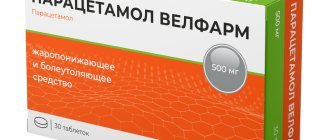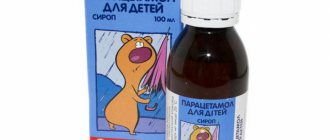Paracetamol 200
From the skin: itching, rash on the skin and mucous membranes (usually erythematous, urticaria), angioedema, exudative erythema multiforme (including Stevens-Johnson syndrome), toxic epidermal necrolysis (Lyell's syndrome).
From the side of the central nervous system (usually develops when taking high doses): dizziness, psychomotor agitation and disorientation.
From the digestive system: nausea, epigastric pain, increased activity of liver enzymes, usually without the development of jaundice, hepatonecrosis (dose-dependent effect).
From the endocrine system: hypoglycemia, up to hypoglycemic coma.
From the hematopoietic organs: anemia, sulfhemoglobinemia and methemoglobinemia (cyanosis, shortness of breath, heart pain), hemolytic anemia (especially for patients with glucose-6-phosphate dehydrogenase deficiency). With long-term use in large doses - aplastic anemia, pancytopenia, agranulocytosis, neutropenia, leukopenia, thrombocytopenia.
From the urinary system: (when taking large doses) - nephrotoxicity (renal colic, interstitial nephritis, papillary necrosis). Overdose. Symptoms (acute overdose develops 6-14 hours after taking paracetamol, chronic - 2-4 days after exceeding the dose) of acute overdose: dysfunction of the gastrointestinal tract (diarrhea, loss of appetite, nausea and vomiting, abdominal discomfort and/or pain in stomach), increased sweating.
Symptoms of chronic overdose: a hepatotoxic effect develops, characterized by general symptoms (pain, weakness, adynamia, increased sweating) and specific ones characterizing liver damage. As a result, hepatonecrosis may develop. The hepatotoxic effect of paracetamol may be complicated by the development of hepatic encephalopathy (thought disturbances, central nervous system depression, stupor), convulsions, respiratory depression, coma, cerebral edema, hypocoagulation, development of disseminated intravascular coagulation syndrome, hypoglycemia, metabolic acidosis, arrhythmia, collapse. Rarely, liver dysfunction develops suddenly and can be complicated by renal failure (renal tubular necrosis).
Treatment: administration of SH-group donors and precursors for the synthesis of glutathione - methionine 8-9 hours after an overdose and N-acetylcysteine - after 12 hours. The need for additional therapeutic measures (further administration of methionine, intravenous administration of N-acetylcysteine) is determined in depending on the concentration of paracetamol in the blood, as well as on the time elapsed after its administration.
Paracetamol tablets 200 mg No. 10x2
Name
Paracetamol tablet 200 mg in container pack No. 10x2
Dosage form
Tablets 200 mg
Compound
One tablet contains the active substance - paracetamol 200 mg, excipients: povidone, croscarmellose sodium, stearic acid, potato starch.
Description
Tablets, white or off-white with a creamy tint, flat-cylindrical, scored and chamfered
Pharmacotherapeutic group
Analgesics. Other analgesics-antipyretics. Anilides. Paracetamol Code ATC N02BE01
Pharmacological properties
Pharmacokinetics After oral administration, it is rapidly absorbed mainly in the small intestine, mainly by passive transport. After a single dose of 500 mg, the maximum plasma concentration is reached after 0.5–2 hours and is about 16 mcg/ml, after which it gradually decreases to a level of 11–12 mcg/ml 6 hours after administration. With repeated administration of the drug, its pharmacokinetics do not change. Cumulation of the drug is not observed. In plasma, about 10–15% of the drug is in a protein-bound state. Penetrates well through histohematic barriers, evenly distributed throughout organs and tissues (with the exception of adipose tissue). Passes through the blood-brain barrier, the placenta, and enters breast milk (less than 1% of the dose taken). The volume of distribution (Vd) is 0.95 l/kg. Metabolized in the liver in three independent ways: 1) conjugation with glucuronic acid (about 50%) with the formation of inactive metabolites; 2) conjugation with sulfates (about 30%) with the formation of inactive metabolites; 3) hydroxylation by the cytochrome P450 system with the formation of the active intermediate metabolite N-acetyl-benzoiminoquinone (N-ABI about 17%). N-ABI subsequently binds to glutathione and undergoes inactivation to form paracetamol mercaptopurate with the participation of mercaptopurine and cysteine. With a lack of glutathione, N-ABI can block the enzyme systems of hepatocytes and cause their necrosis. In premature babies, newborns and children under 10 years of age, the main metabolite of paracetamol is paracetamol sulfate; in children over 12 years of age, the main metabolite of paracetamol is glucuronide. The half-life of paracetamol (T1/2) is 2–3 hours. In children it is slightly less, in newborns, the elderly and patients with impaired liver function it is slightly longer. Excreted by the kidneys in the urine, 30.5 - 58.5% in the form of glucuronide, 17.5 - 33.9% - in the form of sulfate, 4.5 - 6.1% - in the form of paracetamol mercaptopurate, 0.4 - 5 .9% - in the form of paracetamol-cysteine and 3.5 - 4.5% - unchanged. Excreted in the form of metabolites in the urine.
Pharmacodynamics
Paracetamol has an analgesic and antipyretic effect. The mechanism of action is associated with inhibition of the activity of cyclooxygenase types I and II (COX-I and COX-II). As a result, the reactions of the arachidonic cascade of eicosanoid synthesis are blocked and the formation of prostaglandins PgE2, PgF2a, and their endoperoxides is disrupted. Paracetamol has an analgesic effect and increases the threshold of excitability of the pain centers of the thalamus. At the same time, it reduces the activity of the thermosetting center of the hypothalamus, the influence of endogenous pyrogens on it, and enhances heat transfer. It is effective for pain of mild and moderate intensity, fever of infectious origin. It is used as an analgesic and antipyretic, primarily in persons with contraindications to taking other non-steroidal anti-inflammatory drugs: patients with bronchial asthma, peptic ulcers, children with viral infections. The drug does not have an anti-inflammatory effect and does not have an antiplatelet effect. This is due to its inactivation at the site of inflammation under the influence of oxygen peroxide and free radicals, which are formed in abundance at the site of inflammation. Thus, in the area of inflammation, cyclooxygenase remains protected from the action of paracetamol and the anti-inflammatory effect does not develop. Paracetamol can be used in the treatment of pain in patients with disorders of the blood coagulation system (hemorrhagic diathesis, coagulopathies).
Indications for use
- moderately severe pain syndrome (including headache, migraine, neuralgia, toothache, sore throat, pain due to osteoarthritis) - febrile syndrome in acute infectious, infectious-inflammatory diseases.
Directions for use and doses
For oral administration, 1-2 hours after meals (taking immediately after meals leads to a delay in the onset of action), take with plenty of liquid. This dosage form is not used in children under 6 years of age. Children 6-12 years old: 200 - 400 mg (1 - 2 tablets) every 6 hours, maximum daily dose - 1500 mg (weight up to 30 kg) or 2000 mg (weight up to 40 kg). The frequency of administration is 3-4 times a day. The maximum duration of treatment when used as an analgesic and antipyretic is no more than 3 days. Do not exceed the indicated dose. In case of overdose, consult a doctor immediately, even if you feel well.
Side effects
- allergic reactions, skin rash, urticaria, angioedema, anaphylaxis, Stevens-Johnson syndrome - hepatotoxic effect with long-term use - nausea, epigastric pain - hemolytic and aplastic anemia, thrombocytopenia, agranulocytosis, pancytopenia, methemoglobinemia - nephrotoxic effect in the form of aseptic pyuria , interstitial nephritis, papillary necrosis - low blood pressure, hypoglycemia, dyspnea, vasculitis.
Contraindications
hypersensitivity to paracetamol or other components of the drug; deficiency of glucose-6-phosphate dehydrogenase; renal and liver failure; blood diseases; pregnancy and lactation; children under 6 years of age.
Drug interactions
When used simultaneously with cytochrome P450 inducers (phenytoin, alcohol, barbiturates, rifampicin, phenylbutazone, tricyclic antidepressants, combined oral contraceptives), the production of the hydroxylated toxic metabolite N-ABI and the risk of hepatotoxic action of paracetamol increases. Alcohol also enhances the toxic effect of paracetamol on the pancreas and liver. When used simultaneously with cytochrome P450 inhibitors (cimetidine, omeprazole, macrolide antibiotics), the risk of hepatotoxicity of paracetamol is reduced. When taken simultaneously with cholestyramine, cimetidine, omeprazole, the rate of absorption of paracetamol decreases. Paracetamol can be used no earlier than one hour after using cholesterol, no earlier than two hours after using cimetidine, omeprazole. Paracetamol enhances the effect of drugs that depress the central nervous system, potentiates the hematotoxic effect of chloramphenicol, and weakens the effectiveness of uricosuric drugs (sulfinpyrazone). When used simultaneously with myotropic antispasmodics (drotaverine, papaverine, pitofenone) and m-anticholinergic blockers (fenpiverinium bromide, platyphylline, atropine), a slowdown in the absorption of paracetamol is observed due to slower gastric emptying. When used simultaneously with prokinetic agents (metoclopramide), erythromycin, acceleration of paracetamol absorption is observed due to accelerated gastric emptying. Barbiturates weaken the antipyretic effect of paracetamol. The anticoagulant effect of warfarin and other coumarins may be enhanced by long-term regular use of paracetamol in patients at increased risk of bleeding. Single doses do not have a significant anticoagulant effect. Concomitant use with other drugs containing paracetamol is not recommended.
special instructions
This dosage form is not intended for use in children under 6 years of age. Effect on laboratory parameters. During treatment with paracetamol, it is possible to increase the level of glucose in the blood plasma and distort the results of determining the glycemic profile. Pregnancy and lactation period. The use of paracetamol during pregnancy and lactation is contraindicated. If it is necessary to use paracetamol during lactation, the child should be weaned from the breast for the entire period of treatment. Features of the effect of the drug on the ability to drive vehicles or potentially dangerous mechanisms Does not affect the ability to drive vehicles or potentially dangerous mechanisms.
Overdose
Occurs when taking paracetamol in a dose of more than 10 g/day (or more than 140 mg/kg/day in children). In patients with alcoholism and hepatitis, the toxic effect of paracetamol can occur even when used at a dose of 2.5–4.0 g/day. Symptoms: There are 3 stages of intoxication development. Stage 1 (12 – 24 hours) is characterized by dyspeptic symptoms, symptoms of gastrointestinal irritation, nausea, vomiting, and sweating. Stage 2 (2 × 3 days) is characterized by nausea, vomiting, increased levels of transaminases, bilirubin, and an increase in the prothrombin index to 2.0 – 2.5. Stage 3 (3–5 days) is observed in 20% of people with intoxication and is characterized by deep progressive necrosis of hepatocytes, nausea, uncontrollable vomiting, jaundice, a sharp increase in transaminases, bilirubin, and an increase in the prothrombin index of more than 2.5. Signs of liver failure, hypoglycemia, encephalopathy, stupor, renal failure and myocardial dystrophy appear. Treatment: discontinuation of the drug, gastric lavage with activated charcoal and administration of saline laxatives to prevent absorption of the drug in the stomach and intestines. Intravenous administration of glucose is started (5 - 10% solution 200 - 400 ml). A specific antidote is introduced - N-acetylcysteine (restores glutathione reserves and eliminates its deficiency, while the toxic metabolite of paracetamol is neutralized). A 20% solution of N-acetylcysteine is used intravenously and orally: the first dose is 140 mg/kg (0.7 ml/kg), then 70 mg/kg (0.35 ml/kg). A total of 17 doses are administered. The most effective treatment is started in the first 10 hours after the development of intoxication. If more than 36 hours have passed since intoxication, treatment is ineffective. When the prothrombin index increases by more than 1.5, vitamin K1 (phytomenadione) 1 - 10 mg is used; if the prothrombin index increases to more than 3.0, it is necessary to begin intravenous administration of native plasma or a concentrate of coagulation factors (1 - 2 units). When treating intoxication, forced diuresis and hemodialysis are contraindicated. It is unacceptable to use antihistamines and glucocorticosteroids.
Release form and packaging
10 tablets each in a contoured cell-free package made of a combination of paper and cardboard material. Contour cellless packaging together with the appropriate number of instructions for medical use in the state and Russian languages in group packaging.
Storage conditions
Store in a dry place, protected from light, at a temperature not exceeding 25°C. Keep out of the reach of children!
Shelf life
3 years Do not use after expiration date.
Conditions for dispensing from pharmacies
Over the counter
Buy Paracetamol tablet 200 mg in container pack No. 10x2 in the pharmacy
Price for Paracetamol tablet 200 mg in container pack No. 10x2
Instructions for use for Paracetamol tablet 200 mg in container pack No. 10x2

